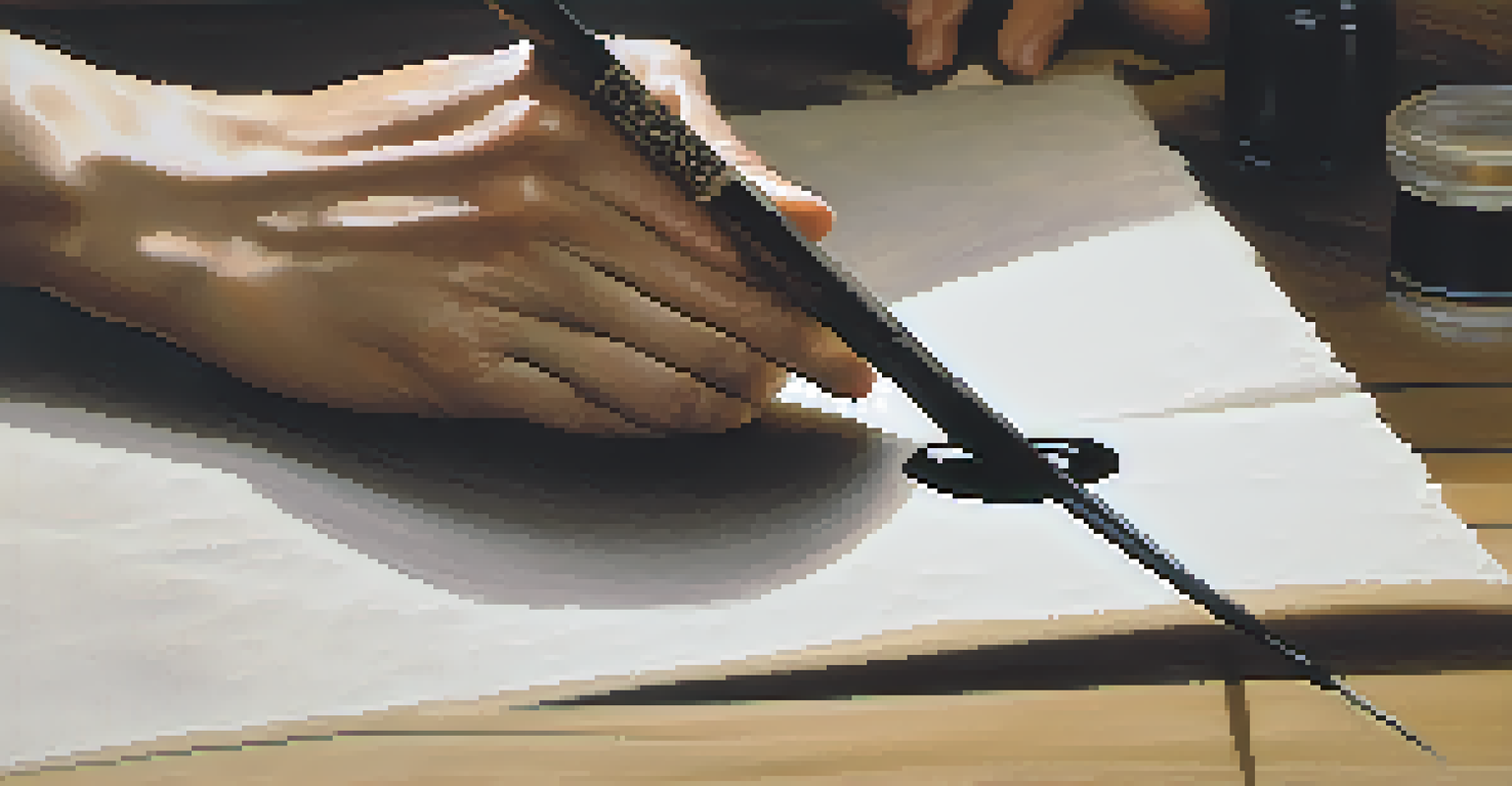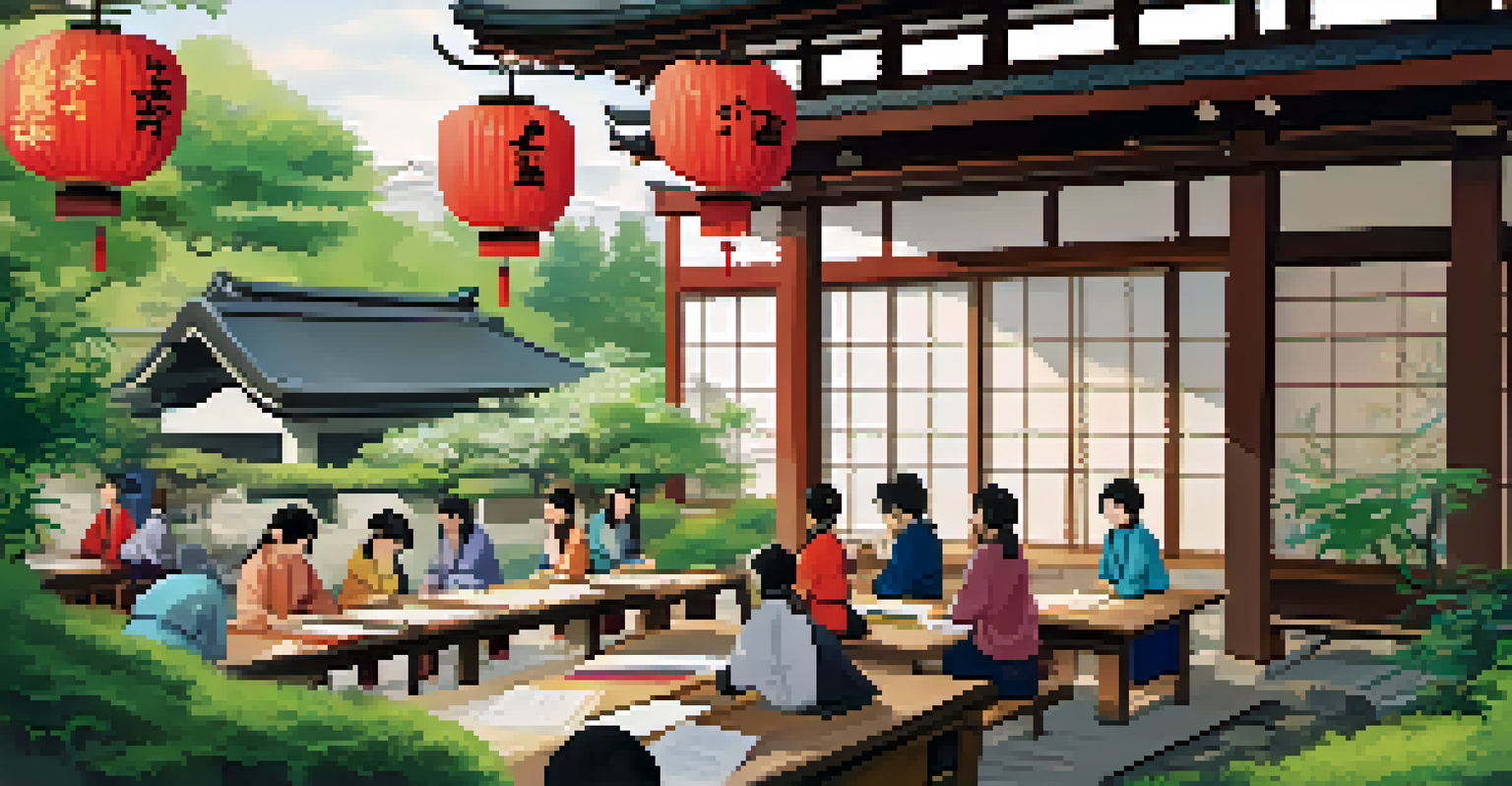The Role of Japanese Calligraphy in Cultural Expression

Understanding Japanese Calligraphy: A Brief Overview
Japanese calligraphy, or 'shodo', is an art form that combines writing and aesthetics. It’s not just about forming letters; it's about expressing emotions and ideas through brush strokes. Originating from Chinese calligraphy, shodo has evolved into a unique Japanese art that reflects the culture's values and philosophies.
Calligraphy is a bridge between the past and present, a way to express the emotions of the heart and the thoughts of the mind.
The tools used in shodo are simple yet significant. A brush, ink, paper, and an ink stone are all that’s needed, yet the results can be profoundly intricate. Each tool plays a vital role in the creation process, emphasizing the importance of craftsmanship and dedication.
Calligraphy in Japan is often seen as a meditative practice. As practitioners concentrate on their strokes, they cultivate mindfulness and presence, allowing them to connect deeply with their cultural roots. This aspect of shodo highlights not only skill but also the spiritual journey involved in the art.
Cultural Heritage: Calligraphy as a Reflection of Identity
Japanese calligraphy serves as a mirror for cultural identity, showcasing the values and aesthetics prevalent in society. Through the fluidity of the brushwork, one can see influences of historical events, philosophical beliefs, and even regional characteristics. Each piece tells a story, providing insights into the artist's perspective.

The characters chosen in calligraphy often hold significant meaning. For instance, writing the character for 'peace' (平和) during times of conflict can serve as a powerful reminder of hope and unity. This intentional selection of characters allows calligraphy to act as a form of cultural commentary.
Calligraphy as Cultural Expression
Japanese calligraphy, or shodo, serves as a reflection of cultural identity and values, showcasing the artist's perspective through brushwork.
Moreover, calligraphy is often incorporated into various aspects of life, from traditional ceremonies to contemporary art exhibitions. This blending of old and new keeps the practice alive and relevant, reinforcing its role as an essential component of Japanese cultural expression.
The Spiritual Essence of Calligraphy in Japanese Culture
Shodo is deeply intertwined with spirituality in Japanese culture. Many practitioners see it as a way to connect with higher principles and the universe, emphasizing harmony and balance. This spiritual connection transforms the act of writing into a profound experience, where each stroke is infused with intention and reverence.
Art is the most beautiful of all lies; it is the truth that we cannot express in words.
Rituals often accompany calligraphy practice, such as the preparation of materials and the setting of the workspace. These rituals enhance the meditative quality of shodo, helping artists focus and channel their energy into their work. As a result, each piece becomes not only a visual representation but also a spiritual offering.
Additionally, the concept of 'ichi-go ichi-e,' or 'one time, one meeting,' underscores the impermanence and uniqueness of each moment in calligraphy. This philosophy encourages artists to embrace the present, making every stroke a reflection of their inner state and a testament to their journey.
Calligraphy in Education: Teaching Tradition and Values
In Japan, calligraphy is taught in schools as part of the curriculum, emphasizing its importance in cultural education. Students learn not only the technical skills but also the underlying philosophies that guide the art form. This education fosters a sense of pride and appreciation for their cultural heritage.
Through calligraphy classes, children learn patience, discipline, and the value of practice. These lessons extend beyond the classroom, encouraging them to apply these principles in other areas of life. This holistic approach to education ensures that the art form remains relevant and cherished across generations.
Spiritual Connection in Shodo
The practice of calligraphy is deeply spiritual, emphasizing harmony and balance while transforming each stroke into a meaningful experience.
Moreover, school calligraphy exhibitions allow students to showcase their work, fostering a community spirit and encouraging collaboration. These events celebrate not only individual achievement but also a collective connection to cultural expression, reinforcing the role of calligraphy in society.
Modern Interpretations: Calligraphy in Contemporary Art
As Japan embraces modernity, calligraphy has found its place in contemporary art. Artists are experimenting with shodo techniques, blending traditional methods with modern aesthetics to create innovative pieces. This fusion encourages a dialogue between the past and the present, showcasing the versatility of the art form.
Many contemporary artists use calligraphy to address social issues, infusing their work with personal and political messages. By incorporating shodo into modern art, they bridge cultural divides and engage new audiences. This evolution keeps the art alive, ensuring it resonates with younger generations.
Exhibitions featuring contemporary calligraphy often challenge viewers' perceptions, inviting them to reconsider what calligraphy can be. By breaking free from traditional confines, these artists demonstrate that the essence of shodo can adapt while still honoring its rich history.
Global Influence: The Spread of Japanese Calligraphy
Japanese calligraphy has transcended borders, captivating audiences worldwide. As globalization continues to connect cultures, shodo has gained recognition as a unique form of artistic expression. Workshops and classes are now offered in various countries, allowing people to experience this cultural heritage firsthand.
The internet has played a crucial role in promoting Japanese calligraphy on a global scale. Social media platforms showcase artists’ works, inspiring others to explore the art form. Through online tutorials and virtual exhibitions, shodo is reaching new audiences and fostering international appreciation.
Modern Adaptations of Shodo
Contemporary artists are blending traditional calligraphy techniques with modern aesthetics, fostering a dialogue between past and present.
This global interest has also led to cross-cultural collaborations, where artists from different backgrounds incorporate shodo into their work. Such exchanges enrich both the practice and the cultural narrative, creating a vibrant tapestry that reflects a shared human experience.
Preserving Tradition: Challenges and Innovations in Calligraphy
While Japanese calligraphy is steeped in tradition, it faces challenges in the modern world. The rapid pace of life and digitalization can overshadow the appreciation for this art form, making it crucial to find ways to keep shodo relevant. Artists and educators are continually exploring innovative methods to engage new audiences.
One approach is the integration of technology into calligraphy practice. Digital platforms enable artists to share their work and connect with others, while virtual reality experiences can immerse users in the world of shodo. These innovations breathe new life into the tradition, making it accessible to a broader audience.

Moreover, community initiatives and cultural festivals dedicated to calligraphy help raise awareness and foster appreciation. By celebrating this art form in diverse settings, practitioners can inspire a new generation to embrace their cultural roots while exploring the potential for innovation and creativity.